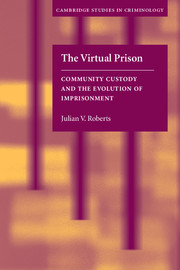Book contents
- Frontmatter
- Contents
- List of figures and tables
- Foreword by Andrew Ashworth
- Preface
- 1 Introduction to the concept of community custody
- 2 The way we punish now
- 3 Conceptualizing community custody
- 4 Representative models of community custody
- 5 Coming home to prison: offender perceptions and experiences
- 6 The effect of community custody on prison admissions
- 7 Public attitudes to community custody
- 8 Making community custody sentences work
- Notes
- References
- Index
- References
References
Published online by Cambridge University Press: 07 December 2009
- Frontmatter
- Contents
- List of figures and tables
- Foreword by Andrew Ashworth
- Preface
- 1 Introduction to the concept of community custody
- 2 The way we punish now
- 3 Conceptualizing community custody
- 4 Representative models of community custody
- 5 Coming home to prison: offender perceptions and experiences
- 6 The effect of community custody on prison admissions
- 7 Public attitudes to community custody
- 8 Making community custody sentences work
- Notes
- References
- Index
- References
- Type
- Chapter
- Information
- The Virtual PrisonCommunity Custody and the Evolution of Imprisonment, pp. 199 - 214Publisher: Cambridge University PressPrint publication year: 2004



